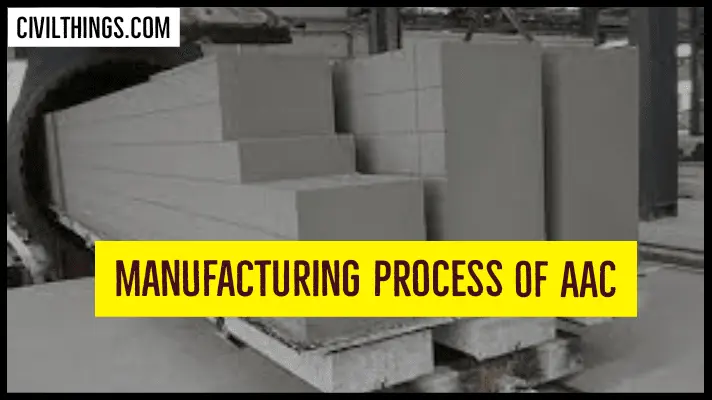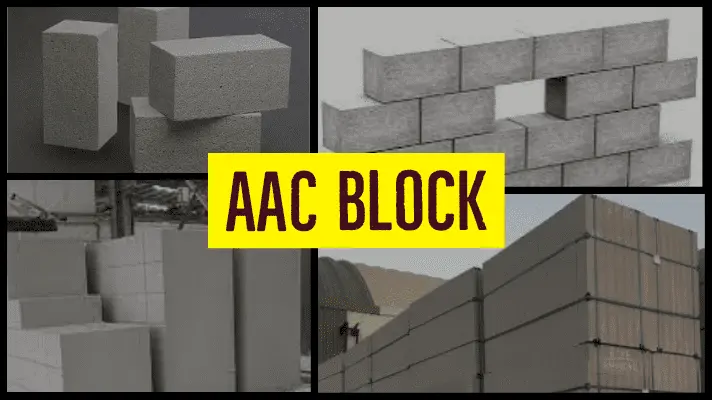AAC block is a minimal maintenance pre-cast building construction material with excellent thermal and compressive strength. The heat-insulating properties of AAC block will keep the building cool and will result in a reduction in the cost of external heat penetration, which can lead to a significant turn-around in air conditioning or air conditioning costs.
Material used in AAC Block
- Cement
- Sand
- Lime
- Aluminum powder
- Gypsum
- Water
Table of Contents
How Autoclaved Aerated Concrete (AAC) is Made

The manufacturing process of Autoclaved Aerated Concrete (AAC) blocks involves several steps. Here are the typical steps involved in the production of AAC blocks:
Raw Material Preparation:
The primary raw materials used in AAC block production are cement, sand, lime, aluminum powder, and water.
These materials are carefully measured and proportioned to ensure consistency and quality in the final product.
Mixing:
The dry materials (cement, sand, lime, and aluminum powder) are mixed together thoroughly in a large mixer.
Water is added gradually to create a homogenous slurry or mix.
Pouring or Molding:
The prepared mix is poured into molds or casting beds.
The molds can be of various sizes and shapes, depending on the desired final product.
Rising and Pre-curing:
The filled molds are left to rise and expand due to the chemical reaction between aluminum powder and lime.
During this phase, the mix solidifies and forms a porous structure.
Cutting:
After sufficient expansion, the solidified block is cut into individual AAC blocks using cutting machines.
The blocks are cut to the desired size and shape.
Autoclaving:
The cut AAC blocks are then placed in autoclaves, which are large pressure vessels.
The autoclaving process involves subjecting the blocks to high-pressure steam and temperature.
This process cures the blocks, making them hard and durable.
The autoclaving process can take several hours.
Cooling:
After autoclaving, the AAC blocks are removed from the autoclave and allowed to cool gradually.
Rapid cooling can cause cracks, so controlled cooling is essential.
Quality Control:
Quality Control and Consistency Check for AAC Blocks
Blocks that meet the desired standards are packaged and ready for distribution.
Packing and Storage:
The finished AAC blocks are packed and stored in a controlled environment to prevent moisture absorption.
Distribution
The manufactured AAC blocks are shipped to construction sites or distributors for use in various building projects.
If you find Good Quality AAC Block Near areas
AAC BLOCK PRICE
| Block Size (in inches) | Block Type | Price per Block ($) |
|---|---|---|
| 24 x 8 x 8 | Standard AAC Block | ₹ 4,100/ Cubic Meter |
| 24 x 8 x 6 | Half Block | [Price] |
| 24 x 8 x 4 | Thin Block | [Price] |
| 24 x 8 x 12 | Jumbo Block | [Price] |
| 32 x 8 x 8 | Large AAC Block | ₹ 4,500/ Cubic Meter |
Factors that can influence the cost such as block size and type.

Block size: If the block size is larger, its cost may increase. A single oversize block may increase the purchase price.
Block Type: Different types of blocks are available, and their type can vary depending on the type of your project in the procurement cost. The block price varies depending on the type.
Factors resulting from size and type, or asking for cost variances, can resolve how your building budget and requirements differ.
Features of ACC block
| Feature | Description |
|---|---|
| Lightweight | AAC blocks are significantly lighter than traditional concrete blocks, making them easier to handle and transport. |
| Insulating Properties | They offer excellent thermal insulation, helping to regulate indoor temperatures. |
| Fire Resistance | AAC blocks have a high level of fire resistance due to their mineral composition. |
| Sound Insulation | They provide good sound insulation, reducing noise transmission between rooms. |
| Eco-Friendly | AAC production uses less energy and produces fewer emissions compared to traditional concrete. |
| Sustainability | AAC blocks use readily available raw materials such as sand, cement, and lime. |
| Durability | They are durable and can withstand various weather conditions and pests. |
| Precision Sizes | AAC blocks are manufactured with precision, ensuring uniformity in size and shape. |
| Ease of Cutting and Drilling | They can be easily cut and drilled for customized installations. |
| Low Maintenance | Minimal maintenance is required over the life of the structure. |
| Rapid Construction | AAC blocks facilitate faster construction due to their lightweight nature. |
| Versatility | Suitable for various construction applications, including walls, floors, and roofs. |
| Energy Efficiency | They contribute to energy-efficient buildings, reducing heating and cooling costs. |
| Load-Bearing Capability | AAC blocks can bear significant loads, making them suitable for structural components. |
| Moisture Resistance | They are resistant to moisture and do not promote mold or rot. |
| Environmentally Friendly Production | AAC production generates less waste and uses fewer resources compared to traditional bricks. |
| Design Flexibility | They offer design flexibility with different finishes and coatings. |
| Longevity | AAC structures have a long service life with minimal degradation over time. |
Advantages and disadvantages of AAC (Autoclaved Aerated Concrete) blocks:

| Aspect | Advantages | Disadvantages |
|---|---|---|
| Lightweight | Easy to handle and transport. | Limited load-bearing capacity. |
| Insulation | Excellent thermal and sound insulation. | Relatively higher initial cost. |
| Fire Resistance | High fire resistance due to mineral content. | Vulnerable to sustained high heat. |
| Eco-Friendly | Environmentally friendly production process. | Energy-intensive manufacturing. |
| Sustainability | Uses locally available raw materials. | Limited availability in some regions. |
| Durability | Durable and withstands weather conditions. | Susceptible to physical damage. |
| Energy Efficiency | Reduces heating and cooling costs. | Limited structural design flexibility. |
| Low Maintenance | Requires minimal maintenance. | Precise installation is crucial. |
| Rapid Construction | Faster construction due to lightweight nature. | Specialized cutting tools required. |
| Design Flexibility | Design flexibility with various finishes. | May require skilled labor for installation. |
AAC blocks vs CLC blocks: Which is better?
| Characteristic | AAC Blocks | CLC Blocks |
|---|---|---|
| Composition | Cement, sand, lime, and aluminum powder. | Cement, fly ash, foam, and additives. |
| Manufacturing Process | Autoclaved curing process. | Air-cured or water-cured process. |
| Compressive Strength | Higher compressive strength, typically around 3-4 MPa. | Lower compressive strength, typically around 2-3 MPa. |
| Density | Higher density, generally ranging from 600-800 kg/m³. | Lower density, typically around 400-800 kg/m³. |
| Thermal Insulation | Good thermal insulation properties. | Offers reasonable thermal insulation. |
| Sound Insulation | Provides effective sound insulation. | Offers moderate sound insulation. |
| Cost | Generally higher cost per block. | Comparatively lower cost per block. |
| Weight | Heavier than CLC blocks. | Lighter in weight, easier to handle. |
| Eco-Friendly | Environmentally friendly production process. | Environmentally friendly, uses fly ash. |
| Construction Speed | Slower construction due to curing in autoclave. | Faster construction, no autoclave curing. |
| Design Flexibility | Offers design flexibility with different sizes and finishes. | Limited design flexibility. |
| Structural Strength | Suitable for load-bearing walls. | Not as suitable for heavy load-bearing applications. |
| Market Availability | Widely available in many regions. | Availability may vary by location. |
Conclusion

Finally, AAC (Autoclaved Aerated Concrete) blocks are a versatile and durable building material that offers many advantages in construction. They provide excellent thermal insulation, fire resistance and sound insulation, making them an ideal choice for various building applications.
The manufacturing process of AAC blocks involves careful preparation of raw materials, mixing, moulding, raising, cutting, autoclaving and quality control. This meticulous process ensures the production of durable and high-quality blocks.
Important Links
- New High Court Building construction recently completed
- Advantages and Disadvantages Longest National Highways
- What are the different types of road barriers?
- Do you know about Percentage rate contract
- What is filtration/theory of filtration?

Hi! I’m Sandip, a civil engineer who loves sharing about Civil Engineering & new ideas and tips. My blog helps you learn about engineering in a fun and easy way!


Informative article. Thanks for sharing